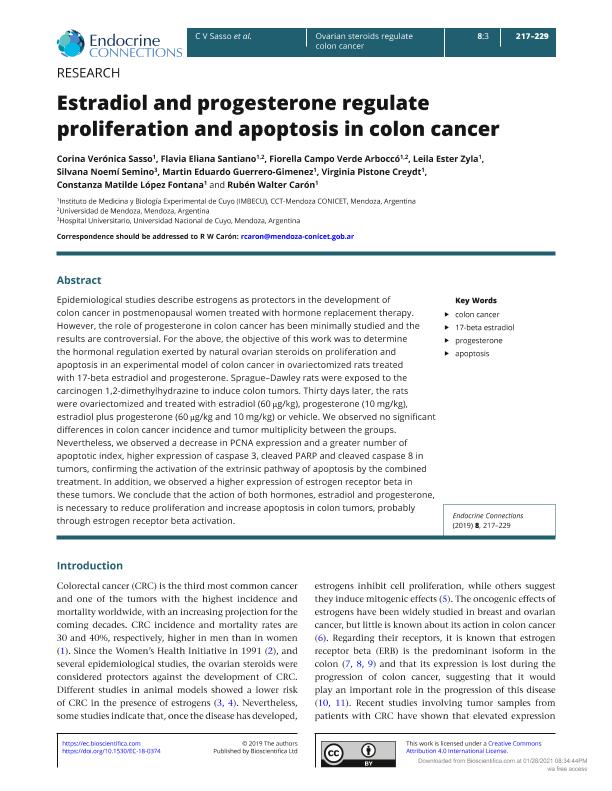Artículo
Estradiol and progesterone regulate proliferation and apoptosis in colon cancer
Sasso, Corina Verónica ; Santiano, Flavia Eliana
; Santiano, Flavia Eliana ; Campo Verde Arbocco, Fiorella
; Campo Verde Arbocco, Fiorella ; Zyla, Leila Ester
; Zyla, Leila Ester ; Semino, Silvana Noemí; Guerrero Gimenez, Martin Eduardo
; Semino, Silvana Noemí; Guerrero Gimenez, Martin Eduardo ; Pistone Creydt, Virginia
; Pistone Creydt, Virginia ; López Fontana, Constanza Matilde
; López Fontana, Constanza Matilde ; Caron, Ruben Walter
; Caron, Ruben Walter
 ; Santiano, Flavia Eliana
; Santiano, Flavia Eliana ; Campo Verde Arbocco, Fiorella
; Campo Verde Arbocco, Fiorella ; Zyla, Leila Ester
; Zyla, Leila Ester ; Semino, Silvana Noemí; Guerrero Gimenez, Martin Eduardo
; Semino, Silvana Noemí; Guerrero Gimenez, Martin Eduardo ; Pistone Creydt, Virginia
; Pistone Creydt, Virginia ; López Fontana, Constanza Matilde
; López Fontana, Constanza Matilde ; Caron, Ruben Walter
; Caron, Ruben Walter
Fecha de publicación:
03/2019
Editorial:
BioScientifica
Revista:
Endocrine Connections
ISSN:
2049-3614
Idioma:
Inglés
Tipo de recurso:
Artículo publicado
Clasificación temática:
Resumen
Epidemiological studies describe estrogens as protectors in the development of colon cancer in postmenopausal women treated with hormone replacement therapy. However, the role of progesterone in colon cancer has been minimally studied and the results are controversial. For the above, the objective of this work was to determine the hormonal regulation exerted by natural ovarian steroids on proliferation and apoptosis in an experimental model of colon cancer in ovariectomized rats treated with 17-beta estradiol and progesterone. Sprague–Dawley rats were exposed to the carcinogen 1,2-dimethylhydrazine to induce colon tumors. Thirty days later, the rats were ovariectomized and treated with estradiol (60 μg/kg), progesterone (10 mg/kg), estradiol plus progesterone (60 μg/kg and 10 mg/kg) or vehicle. We observed no significant differences in colon cancer incidence and tumor multiplicity between the groups. Nevertheless, we observed a decrease in PCNA expression and a greater number of apoptotic index, higher expression of caspase 3, cleaved PARP and cleaved caspase 8 in tumors, confirming the activation of the extrinsic pathway of apoptosis by the combined treatment. In addition, we observed a higher expression of estrogen receptor beta in these tumors. We conclude that the action of both hormones, estradiol and progesterone, is necessary to reduce proliferation and increase apoptosis in colon tumors, probably through estrogen receptor beta activation.
Palabras clave:
17-BETA ESTRADIOL
,
APOPTOSIS
,
COLON CANCER
,
PROGESTERONE
Archivos asociados
Licencia
Identificadores
Colecciones
Articulos(IMBECU)
Articulos de INST. DE MEDICINA Y BIO. EXP. DE CUYO
Articulos de INST. DE MEDICINA Y BIO. EXP. DE CUYO
Citación
Sasso, Corina Verónica; Santiano, Flavia Eliana; Campo Verde Arbocco, Fiorella; Zyla, Leila Ester; Semino, Silvana Noemí; et al.; Estradiol and progesterone regulate proliferation and apoptosis in colon cancer; BioScientifica; Endocrine Connections; 8; 3; 3-2019; 217-229
Compartir
Altmétricas



